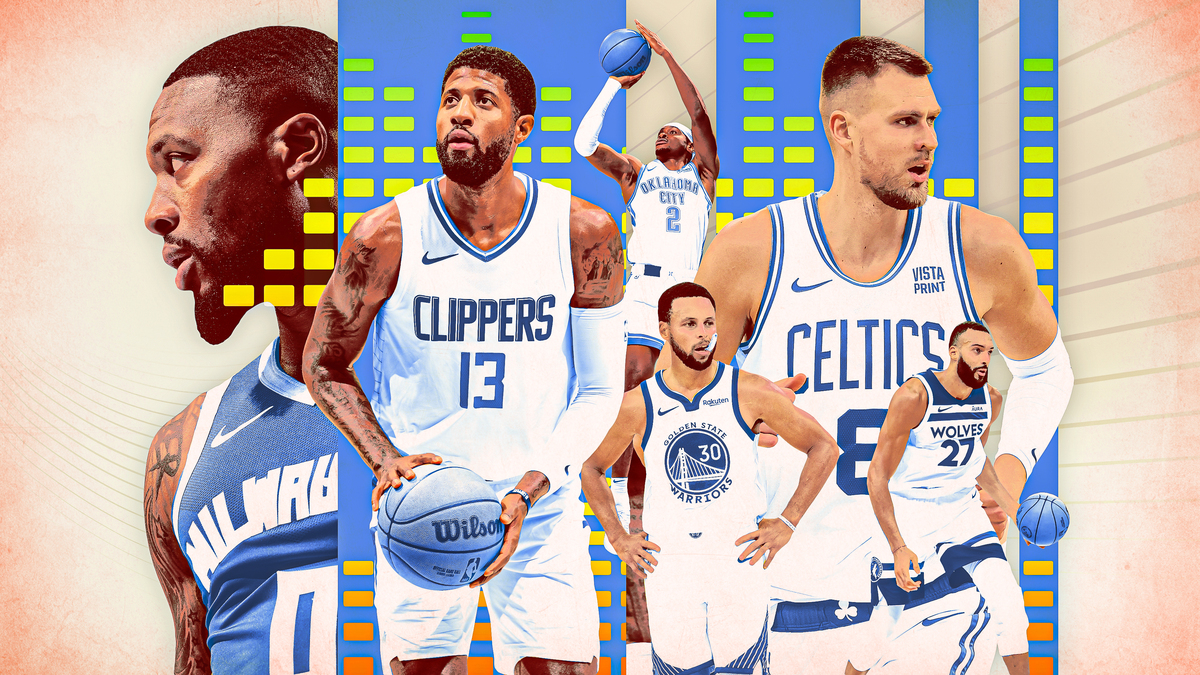Kevin Durant came off a screen midway through the fourth quarter of the Los Angeles Lakers’ home opener, and a buzz of excited murmurs rippled through the Crypto.com Arena. LeBron James switched on him, guarding his longtime peer for the first time since their last matchup, somehow more than 1,700 days ago.
It was a brief five-second interaction, made more significant by its fleeting nature. The fragility of the moment was not lost on the crowd or on LeBron, who will turn 39 years old in two months. “I mean,” James said after the game. “Just … we don’t have many matchups left. Not sure how many we have left. So you don’t take it for granted when you’re out there with such a great player, one of the best to play this game.”
There was a time when James was in an all-out assault against the notion of his decline, mustering up #WashedKing en route to his last ring in 2020. But those days are over. James, the oldest active player in the NBA, is now in his acceptance stage. He is grateful for what he has left in the tank, and his goal this season is to preserve as much of it as possible.
This summer, James, his trainer Mike Mancias, the Lakers front office, and their coaching staff convened to design a maintenance plan that would allow LeBron, who played through a foot injury last postseason, to enter this year’s playoffs with fresh legs. The Lakers’ championship hopes hinge on how well they can seize on what James can offer today while preserving what he may be able to offer this spring if all goes according to plan.
It was fair to wonder, during a Lakers timeout with five minutes left in Thursday’s game, whether that LeBron vs. KD moment was the last we’d get that night. James had played 30 minutes, and it was revealed after a 29-minute outing against the Denver Nuggets on opening night that he will have his minutes restricted for the first time in his career. But a decision to bypass that monitoring had already been made. James was the first player to walk out of the huddle and back to the scorers table, throwing the towel he was using to wipe sweat off his brow to the side before reentering the game.
What followed, between timeouts, was a series of turn-back-the-clock no-regard-for-human-life drives to the rim from LeBron, including a split of two defenders and a transition summit between KD and LeBron that sent the latter to the free throw line. James, who played every minute of the fourth quarter and 35 overall, took full command of the offense, demanding the ball after stops, running pick-and-roll after pick-and-roll with Anthony Davis.
Thanks to Davis and Christian Wood, who both led a successful attempt to suppress Durant, and LeBron’s late heroics on offense, the Lakers escaped with a 100-95 win against the Suns, who were down two of their Big Three.
“It’s beautiful to watch,” said Lakers coach Darvin Ham of LeBron’s 21-point, nine-assist, and eight-rebound performance. “And we needed every ounce of it.”
Entering the fourth quarter against the Suns, Ham faced a decision he will repeatedly have to make this season. With the Lakers down by 12, Ham, armed with three timeouts to give James breathers throughout the final period, asked his veteran star whether he felt good enough to play the duration.
“I looked at the time, the score, what was going on in the game,” said James. “It was an easy answer for myself.”
When I asked after the game whether he ever thought he’d have to save LeBron from himself, Ham remarked that he did that in Denver three nights earlier. “It’s funny, man,” he continued, laughing and shaking his head. “You guys want everything. I take him out, it’s ‘Why didn’t you keep him in?’ If I leave him in, ‘Why won’t you take him out?’”
Ham continued, “You guys want a buffet, man. Sometimes you just gotta settle for one plate.”
In fairness to us, LeBron once offered an all-you-can-eat 24-hour menu with an endless supply of everything, from a 40-point barrage to a 19-rebound triple-double.
Even in his jovial frustration, Ham got to the heart of why so much focus is on whether LeBron plays 29 minutes or 35: When Ham took James out against Denver, the Lakers were down four. By the time he checked back in, a minute and 44 seconds later, the Nuggets were up 12. James was at plus-22 against the Suns and was the reason the Lakers aren’t starting the season 0-2.
If 35 minutes, LeBron’s season average last year, is his new upper limit this year, that’s still pretty good. But if the first two games of the season are any indication, LeBron’s load management will be fluid, contingent on more than just his minutes total.
To help James strike the right balance, the Lakers are asking Davis to walk an even tighter rope this season. James, in full-on succession-planning mode, expects the big man to be the face of the franchise this year, an on- and off-court leader who’s also a consistent, aggressive two-way force on a nightly basis.
But it also puts Davis in the difficult position of occasionally having to be in two places at once on the court, and while that very need taps into the crux of his special gifts—his combination of size, agility, and intelligence—it’s a hard thing to ask of a 30-year-old big man with a troublesome injury history.
Davis has long been criticized for his inconsistency (including a zero-point performance in the second half of the season opener), but the Lakers’ breakdowns in transition and on the boards often have a common denominator: Davis is positionally overcommitted because of something his team has asked him to do. Several of the Nuggets’ transition baskets on Tuesday came after Davis tried to bully his way through Nikola Jokic’s burly frame and display the aggression, if not the touch, that has been asked of him.
The problem is that momentum takes one of the Lakers’ best transition defenders, responsible for guarding the best outlet passer in the world, out of the play.
Against the Suns, Davis helped contain Durant on the perimeter, but that left the paint wide open. There are times Davis can and should cover all bases, like on a play in the first quarter when Davis stepped up to Durant on the perimeter to help on a pick but jogged back into the paint and failed to reposition himself to box out Jusuf Nurkic. The reality is that he’ll need help from someone not named LeBron. On Thursday, Wood answered the call.
When the Lakers bolstered their frontcourt this offseason, including by signing Wood, it hearkened back to the days when a younger Davis, reluctant to play center, clogged the floor at the 4 in an increasingly pacier and spacier league. But two-big lineups are trendy again in the same league. Nikola Jokic and Joel Embiid have won the past three MVPs, and the success of the Lakers’ closing lineup against the Suns was a reminder why these big-dominant lineups are so important.
The 7-foot duo of Davis and Wood mauled, trapped, switched, and generally frustrated Durant, impeding his vision and forcing him into ugly shots and turnovers. Wood also covered for Davis on the boards, gobbling up six defensive rebounds in the fourth quarter.
The solution to most of the Lakers’ problems starts with Davis, but accounting for regression from one of the game’s most dominant, versatile players will require a season-long concerted effort from the Lakers’ role players. Rui Hachimura, re-signed this offseason, spent the summer working out with LeBron, learning to be his “understudy.” The return of Austin Reaves and D’Angelo Russell, as well as the free agency signing of Gabe Vincent, also gives the Lakers a plethora of ball handlers to lessen James’s burden.
But during the Nuggets game, James struggled with this very accommodation as the Lakers offense sputtered out of the gate. He had to “remind” Lakers assistant coach Phil Handy that he is capable of playing point guard.
But there’s no guarantee that LeBron would have been able to take over against the Nuggets and reverse the season-opening loss. Maybe if he tried, he wouldn’t have had the energy to fuel a comeback against the Suns three nights later. Now, even when he finds the extra step to get all the way to the rim, there’s more strain in his stride. At this stage of LeBron’s career, he can’t beat Father Time. He can only make concessions to age and hope it’s kind to him in return.


